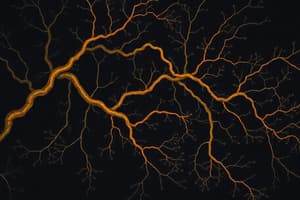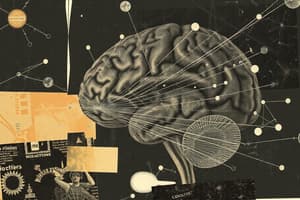Podcast
Questions and Answers
Which of the following best describes the role of melanopsin-containing retinal ganglion cells?
Which of the following best describes the role of melanopsin-containing retinal ganglion cells?
- They are a key component in the magnocellular visual pathway.
- They primarily contribute to the pupillary light reflex.
- They are responsible for processing detailed visual information such as color and shape.
- They project to the suprachiasmatic nucleus and regulate circadian rhythms. (correct)
What is the main function of the superior colliculus in the context of vision?
What is the main function of the superior colliculus in the context of vision?
- Processing detailed color information.
- Serving as a primary relay for visual information to the cortex.
- Coordinating eye and head movements, particularly reflexive responses. (correct)
- Regulating the pupillary light reflex.
Where does the primary visual cortex (V1) receive the majority of its visual input?
Where does the primary visual cortex (V1) receive the majority of its visual input?
- From the superior colliculus.
- From the lateral geniculate nucleus (LGN) of the thalamus. (correct)
- From the hypothalamus.
- Directly from the retina.
Which of the following is a characteristic of simple cells found in the primary visual cortex?
Which of the following is a characteristic of simple cells found in the primary visual cortex?
What are the parvocellular layers of the lateral geniculate nucleus (LGN) primarily responsible for processing?
What are the parvocellular layers of the lateral geniculate nucleus (LGN) primarily responsible for processing?
What does the concept of 'retinotopic mapping' in the visual cortex refer to?
What does the concept of 'retinotopic mapping' in the visual cortex refer to?
Which area of the visual cortex is most associated with motion processing?
Which area of the visual cortex is most associated with motion processing?
What is the role of the 'blobs' found in the primary visual cortex?
What is the role of the 'blobs' found in the primary visual cortex?
Which visual pathway is primarily involved in object recognition?
Which visual pathway is primarily involved in object recognition?
What role does the lateral geniculate nucleus (LGN) play in visual processing?
What role does the lateral geniculate nucleus (LGN) play in visual processing?
What is meant by 'binocular disparity' in the context of vision?
What is meant by 'binocular disparity' in the context of vision?
What is the primary function of the koniocellular (K-cells) pathway in visual processing?
What is the primary function of the koniocellular (K-cells) pathway in visual processing?
What does the term 'ipsilateral' when referring to visual processing mean?
What does the term 'ipsilateral' when referring to visual processing mean?
What is a major characteristic of the magnocellular pathway?
What is a major characteristic of the magnocellular pathway?
Which of the following is NOT considered a monocular cue for depth perception?
Which of the following is NOT considered a monocular cue for depth perception?
Flashcards
Central Visual Pathways
Central Visual Pathways
Four major pathways for visual processing: LGN, hypothalamus, pretectum, and superior colliculus.
Lateral Geniculate Nucleus (LGN)
Lateral Geniculate Nucleus (LGN)
Principal thalamic site for processing visual information with six layers.
Contralateral vs. Ipsilateral
Contralateral vs. Ipsilateral
Contralateral refers to opposite hemispheres; ipsilateral means the same hemisphere.
Retinotopic Mapping
Retinotopic Mapping
Signup and view all the flashcards
Circadian Rhythm
Circadian Rhythm
Signup and view all the flashcards
Melanopsin
Melanopsin
Signup and view all the flashcards
Pupillary Light Reflex
Pupillary Light Reflex
Signup and view all the flashcards
Simple Cells in V1
Simple Cells in V1
Signup and view all the flashcards
Dorsal Pathway
Dorsal Pathway
Signup and view all the flashcards
Ventral Pathway
Ventral Pathway
Signup and view all the flashcards
Binocular Disparity
Binocular Disparity
Signup and view all the flashcards
Functional Columns in Visual Cortex
Functional Columns in Visual Cortex
Signup and view all the flashcards
Superior Colliculus
Superior Colliculus
Signup and view all the flashcards
Motion Detection Area (MT)
Motion Detection Area (MT)
Signup and view all the flashcards
Color Processing Blobs
Color Processing Blobs
Signup and view all the flashcards
Study Notes
Neuronal Staining and Morphology
- Santiago Ramón y Cajal invented a method for staining neurons.
- Neurons are not a single entity; they form a network of separate cells.
Central Visual Pathways
- Visual processing involves parallel pathways.
- Four major pathways originate from the retina:
- Lateral Geniculate Nucleus (LGN) in the thalamus: the primary visual pathway.
- Hypothalamus: regulates circadian rhythm and connects the brain to the body through hormone release.
- Pretectum: controls the pupillary light reflex.
- Superior Colliculus: regulates eye and head movements.
Hypothalamus and Circadian Rhythm
- Polar night effects can lead to polar anemia, sleep disturbances, fatigue, muscle atrophy, heart rhythm issues, cognitive symptoms (like confusion), and emotional problems (like depression).
- Light synchronizes circadian rhythm.
- Melanopsin-containing retinal ganglion cells project to the suprachiasmatic nucleus (SCN).
- These cells are sensitive to blue light; night-time exposure can decrease melatonin, increase blood sugar, and decrease leptin (the fullness hormone).
- The SCN regulates circadian rhythm.
Pretectum and Pupil Control
- Bright light causes pupil constriction.
- Dim light causes pupillary dilation.
Superior Colliculus and Eye/Head Movement
- The superior colliculus controls the orientation of eyes and head.
Visual Field Projection and Fiber Crossing
- The left visual field projects to the right hemisphere, and vice versa.
- The right visual field information is processed in the left hemisphere; right visual field info processed in left hemisphere.
- Information crosses over to the opposite hemisphere (contralateral).
- Parts of the visual field are processed in specific regions of the cortex, with an inverted and reversed representation.
Lateral Geniculate Nucleus (LGN)
- The LGN is a key subcortical visual processing center situated in the back of the thalamus.
- LGN cells have monocular input (from one eye).
- Six layers, top four (parvocellular) have input per eye and bottom two (magnocellular) layers with one input per eye.
- Receives input mainly from retina, but also from cortex and brainstem (modulatory).
- Features retinotopic maps.
Retina Cell Projections to LGN Layers
- M-cells (magnocellular): process movement; large receptive field.
- P-cells (parvocellular): process color, shape, and size; small receptive field.
- K-cells (koniocellular): process short-wavelength light (blue).
- Melanopsin
Primary Visual Cortex (V1)
- V1 has a retinotopic map, with the fovea (center of vision) being highly represented.
- Layers:
- Layer 1: Interneurons.
- Layers 2 and 3: Pyramidal cells and interneurons.
- Layer 4: Receives input from the LGN; highly magnified.
- Layers 5 and 6: Output layers.
- Simple cells in V1 decompose visual images into short lines/segments of different orientations. These cells have bar-shaped receptive fields.
Visual Cortex Organization
- Orientation columns map visual preference.
- Ocular dominance columns represent input from each eye.
- Blobs process colour.
- Functional columns analyze distinct regions for light/dark edges, orientations, movements, colour, and input from either eye.
Beyond V1
- Magnocellular pathway processes movement (to MT).
- Parvocellular pathway processes shape and color (to V4).
- Ventral pathway (temporal lobe) processes object recognition.
- Dorsal pathway (parietal lobe) processes spatial information.
Depth Perception
- Depth perception relies on monocular cues (e.g., familiar size, occlusion) as well as binocular disparity.
- Binocular disparity is the difference in the image seen by each eye; larger disparity suggests that the object is closer.
- Stereoscopic vision is the perception of depth from binocular disparity.
Visual System Summary
- The visual system uses parallel processing across multiple brain regions.
- V1 creates a retinotopic map.
- Visual pathways interact via rich feedback connections.
Sensory Systems General Plan
- Parallel processing in visual pathways.
- Topographic representations (retinotopic maps).
- Information crossing (optic chiasm).
- Rich feedback connections (from cortex to LGN).
Studying That Suits You
Use AI to generate personalized quizzes and flashcards to suit your learning preferences.




